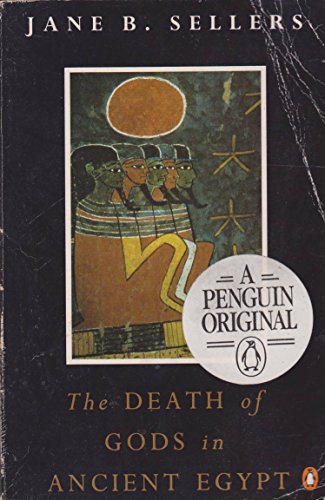In this essay, specially written for grahamhancock.com, Jane Sellers, our Author of the Month for November 2003, sets out some of the key insights and discoveries that led her to her classic book The Death of Gods in Ancient Egypt. Now reprinted and available for the first time in several years, copies of the new edition can be obtained only from Lulu Books. Jane Sellers has agreed to join us on The Mysteries Message Board during November for on-line discussions of her work and ideas.
Thirty years ago I traveled six hundred miles to the middle of the Atlantic to experience my first total solar eclipse. This particular eclipse would have a long period of totality, slightly over 7 minutes, almost the maximum period of totality possible. Arthur Clarke was aboard our ship, the Adventurer, as a guest speaker. Our sister ship, off the coast of Africa, had Isaac Asimov. Science fiction writers you say? Ah yes, good science fiction demands good science; it is the science of tomorrow, or so the astronomers on board insisted. And both these writers were scientists, if not astronomers.
On the day of the eclipse, preparation was intense. Those with cameras and telescopes picked out what they considered the best spots on deck, others staked out chaises, and all felt the heightening sense of anticipation. Of course, much attention was focused on the moments leading up to first contact, the first bite out of the sun, but it was not until second contact, the beginning of totality, that the excitement really began. As the moon’s shadow covered the sun completely, and the signal came to remove eye and lens protection, a great ball of light… the first of two Diamond Ring Effects… suddenly appeared… or “leapt up.”
This amazing image seemed to me to hang there forever…and our shipboard world became absolutely, and eerily, silent. The duration of the Diamond Ring Effect can vary and the longest I have seen it last was 10 seconds, ten awesome seconds, during the eclipse of 1998, off the coast of Aruba. This experience and its effect on me, and the part that the Diamond Ring Effect plays in my theory of the origins of the ancient Egyptian religion is easy and fun to present. It is certainly much easier to defend than is my contention that Egypt’s Neolithic inhabitants, perhaps as early as 7300 BC, and conceivably earlier, were involved in sky observations and oral record keeping. I have suggested that this record keeping enabled them to be aware that the arrival time of important stars had been delayed, and as this process continued, the basic myths of Egypt were born. I have also contended that eventually this mystifying backward pull of the heavens could be measured by the ancient Egyptians.
These are difficult positions to defend, and there are difficult concepts to explain. In the preface of Hamlet’s Mill, before presenting their support for their premise that the roots of the world’s myths are found in the observable results of precession, the authors wrote,”He that will have a cake out of wheat must needs tarry the grinding.”
I echo this, and one can appreciate my preference here for speaking about the conclusions that involved eclipse phenomena. I thoroughly believe that both phenomena served as origins of their most important religious stories, and indeed, became linked in an important eighty-year period described in the mythic record as the “Eighty Years of the Gods’ Contending.”
The precessional changes had presented a very thorny problem… “Should the office go to the murderer?” A trial and the solution, as related in the Egyptian writings, was novel, but I believe that it was a solution that has long muddied understanding of many traditions in this ancient religion.
After my first eclipse experience I had realized that a total solar eclipse, and especially the Diamond Ring Effect, could be the explanation for those seemingly ridiculous and baffling passages that are found in almost all writings and at all periods of ancient Egypt. In truth, my thinking really was, “This eerie ball of light just could be “The Eye of Horus.” The Eye of Horus was ancient Egypt’s most sacred object: the Eye promised rebirth, and life, “forever, and forever.”
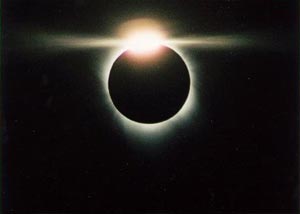
FIG. 26: HARPOON OR THUNDERBOLT?
Photo by Jane Sellers – June 11, 1983, Tuban, Java
In the split seconds just before the appearance of the brilliant flash of the Diamond Ring, one may see tiny beads along the periphery of the black disk, which is really the sun’s corona peeking through the valleys of the moon. Then, this last, seemingly magnified, bead appears, sometimes on top of the sun, sometimes on the bottom, or sometimes anywhere in between, depending on the eclipse path. The “Diamond” itself is accompanied by the corona starting to appear thinly all around the dark sun’s circumference –like the band of a ring.
Then the corona (the sun’s faint outer atmosphere, visible only during totality), flashes out around the eclipsed sun. When this happened on the Adventurer, a great shout went up…and for almost seven minutes one could view the eclipse through unprotected eyes, camera lens, or even the telescope. However, my profoundest emotions were had during the long seconds of wonder right at the beginning of second contact, the seconds when I stared naked eyed at the Diamond Ring…at this enigmatic “thing” hovering on top of our most important giver of light and sustenance, now blotted out.
Who then is it?
Those above their braziers-it is.
The image of the Eye of Re, together
With the image of the Eye of Horus
As mentioned, the period of totality varies, and so does what one sees. If one is fortunate, angry looking reddish prominences appear on the edges of the black sun, visible to the naked eye, and always, there is the magnificent, fiery corona.
Then comes the second Diamond Ring at the instant totality ends. This second or more correctly, the “Third Contact Diamond Ring Effect” is on the opposite side of the solar disk than the first and although I have no picture showing the flash on the bottom, I offer a second eclipse picture.
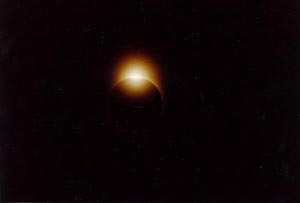
“Look with your faces, O Primeval Ancestors, upon this spirit who comes today, taking the form of a burst of light, coming from the Isle of Fire…Behold, the Eye will be stronger than all the gods!”
One of the many texts that I have used in the book is the preceding one from the Middle Kingdom Coffin Texts.
Or going much further back in time to the Pyramid Texts we can read:
“The Eye has issued from your head as the Upper Egyptian crown Great- of- Magic: the Eye has issued from your head as the Lower Egyptian crown Great-of-Magic.
Or this more obvious eclipse description from the Egyptian Book of the Dead:
‘On The Crest Of That Mountain Is A Snake, ‘He Whose Consuming Fire Is Within Him’ Is His Name. Then After Mid-Day He Will Turn His Eyes Against Re, Then A Stoppage Will Take Place In The Bark And Great Amazement Among The Sailors . . . Then Suty Will Hurl A Spear Of Metal Against Him And Cause Him To Disgorge All That He Has Swallowed’.
When I experienced the Diamond Ring Effect that had lasted ten seconds, it was a Third Contact Diamond Ring, which means that we had been looking at the eclipsed sun with no eye protection during the minutes of totality. The sky seemed darker than at other eclipses that I had experienced, and the black sun, surrounded by its corona, appeared as a hyper-dimensional object, suspended in a night sky. And then…it was as if the hand of god reached up and pulled a light cord. It was as though a high intensity bulb at the bottom of the sun disk had been suddenly switched on. In my memory I see a narrow beacon of bright light emanating from the Diamond Ring down to the water and I can hear the click of a switch…but of course that memory must be in error. Most stared in wonder. A nearby viewer sobbed audibly.
It was the beginning of a very long journey, one in which I consulted with many experts, including the late Richard Parker. I started out with the simple task of accumulating many of the various texts that seemingly described the Diamond Ring Effect in various and greatly differing ways. As the perceptive reader of the ancient writings soon realizes, it would seem that the ancient Egyptians described and explained “unexplainable” things in as many ways as possible. It should be remembered however, that the texts come from different times, separated by many centuries and even millennia. If certain passages and myths originate in eclipse phenomena, total eclipses were not a one time event: others would be seen in the long period of Egypt’s ancient history — and other stories and explanations put forward.
The writings that I examined ranged from the Old Kingdom Pyramid Texts (c. 2300 BC) to the The Lamentations of Isis and Nephthys from the Ptolemaic Period, (304-30 BC) The Middle Kingdom Coffin Texts were reread and New Kingdom (c. 1552-1069 BC) texts, such as The Book of the Dead, The Litany of Re, The Book of the Caverns, The Book of the Gates, The Book of the Amduat, The Chester Beatty Papyrus, and the Papyrus Sallier IV were all included on my list. Artwork from each period was thoroughly scrutinized, and my trips to Egypt increased. But now, a few words about the other half of the story. It was in the late 70’s that an editor/friend said to me, ‘before you write your book you should read Hamlet’s Mill.’ I was a bit surprised, because the book was outside of the prescribed scholarly orbit, despite the fact that the respected physicist, Philip Morrison, in a 1969 review for Scientific American, had written, “It… has the ring of noble metal, although it is only a bent key to the first of many gates.”
After a concerted struggle to understand precession and its observed change in the heavens, and after numerous consultations with astronomers and planetarium directors (I was unaware at that time of any computer programs that would show me this) I understood that this was a necessary addition to my theory of the origins of Egypt’s basic myths.
The theory advanced by Giorgio de Santillana and Hertha von Dechend in Hamlet’s Mill had ended up supplying the unexplained part of my own theory for the origin of Egypt’s basic religious beliefs. It was a very necessary addition because there are two distinct myths that are at the very center of the Egyptian belief system. One is The Death and Resurrection of Osiris; the other is The Contendings of Horus and Seth. Basic to both stories is the very important Eye of Horus, which was taken down to the Netherworld and bestowed eternal life on Osiris… and any Egyptian who partook of a ritual offering that symbolized this sacred object.
The Egyptian texts indicate that they associated their god, Osiris, a god that died and experienced resurrection, with the constellation that we call Orion. It is known that they also associated Osiris with such things as grain, and that Egyptians saw his death and rebirth played out in the seasonal cycle of growing things. However, the writings make it abundantly clear that Osiris’ rebirth was prominently seen in the rising of the distinctive star group, Sahu-Orion. (Are we to suppose that this is the reason for the powerful and enduring legend of Osiris’s death and rebirth? No, we are not. Regarding Orion’s seasonal absence, the texts are clear, “there is no evil in it.”)
If this was a precessional death, as the theory in Hamlet’s Mill suggests, it strongly indicates that there was a star worshipping culture in Egypt, with strong ideas about death and rebirth, much further back in time than Egyptologists will allow. It suggests attempts were being made to establish some kind of benchmark for the year other than one using the moon and its phases,a difficult benchmark at best.
My acceptance of the theory of Hamlet’s Mill hinged on the probability and possibility of very ancient awareness of delayed heliacal risings. (Such a rising is the first appearance of a star after its seasonal invisibility). The important heliacal risings would be those of the stars that heralded the coming of the sun, the sun that would rise either at midpoint on the horizon or at its two extremes, or solstice positions. The midpoint position would be the sunrise that marked the occasion of equal hours of light and darkness between sunrises, an important marker for keeping track of the year, and a twice a year event. (As most will know, there are two equinox dates, the Vernal Equinox and the Autumnal. Historically, the spring date has been the more important of the two.)
My next quest became one to determine, with first-hand experience, the height over the horizon when the heliacal risings of the last stars of Orion could be seen, and then to do the same for the bright stars Aldebaran and Antares, (in a later era the two beautifully acted in concert, visibly marking the date of the vernal and the autumnal equinoxes.) Then, with the recent availability of computer programs, compute the dates that these stars would start, then cease, marking ancient equinox dates with this first appearance after absence. I did not want or need the date of the appearance, or disappearance, of the whole of any star group, such as those that we call Orion and Taurus, I needed information on just one star that might have been used, but it was here that I had difficulty in accepting what my computer program was indicating.
All stars of Orion had ceased an equinox rising by 6700 BC. For Orion’s precessional death to have been noticed, centuries had to have passed during which his arrival time was noted to be later and later, and it must also be conjectured that much earlier than this “death,” the return of Orion had been noted as special, and this specific day given importance. One must speculate a date at least as early as 7300 BC.
The late Michael Hoffman wrote: “Predynastic settlement in the region [of Nekhen in Upper Egypt] was much older than was formerly believed…For a time between 7000 and 2500 BC the deserts bloomed and human societies colonized the areas that have been unable to support such dense populations since.”
I suggest that in the centuries after this loss, the heliacal risings of the bright star, Aldebaran, and the bright star Antares, marked the two equinoxes…Horus and Seth ruled equally, and the Egyptian world was in a wonderful state of balance. That is, until a turbulent period in which the occupier of the most honored position, that of the herald of the vernal equinox sun was also slipping from view. (The date of this would be delayed eighty years as one went south up the Nile).
Amazingly true to the mythic record of eighty years of contending, computer predictions suggested an unusual eighty year period that would carry the eclipse paths of three total eclipses and one annular eclipse over the predynastic settlements along the Nile during this very same period. (4867 BC to 4787 BC.) It is clear in the writings of the ancient Egyptians that they yearned for permanence and stability in their gods…and this was denied them. This long ago period was a time for great myths to be born. It was the time of the eighty years of contending between Horus and Seth. And it was a time when a purpose was given for the eastward movement of Aldebaran to below the horizon.
I became different from the other dwellers in the light beams…and appeared as a Divine Falcon. Horus has invested me with his soul in order to take his news to Osiris in the Underworld. The Egyptian Coffin Texts
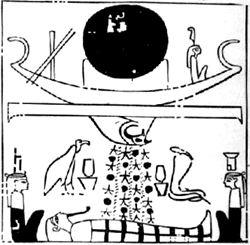
FIG. 13: THE DESCENT OF HORUS TO TAKE HIS EYE TO OSIRIS
The Papyrus of Amon-Em-Saf (Louvre)
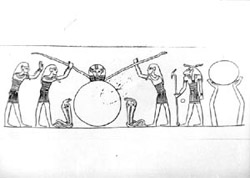
FIG. 19: ‘IN THE ARMS OF THE ABYSS’
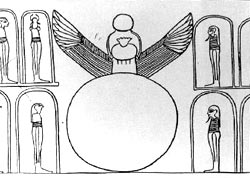
FIG. 22: ‘HE BECOMES GREAT KHEPRI’
At one point in time I contacted Wayne Annala who owned Stellatron, maker of my expensive Lodestar program, and asked him to check my determination of the date that Aldebaran ceased to blaze forth on the spring equinox morning. He too, determined that this event happened way back in time…long before what some call the Age of Taurus. (This would be when all the stars of that star group were obliterated from view by the sun on the vernal equinox date.) And althoughthis early date greatly complicated and prolonged my research, it led to a surprising discovery and an amazing hypothesis, the one advanced in The Death of Gods in Ancient Egypt.
Does my theory postulate a lost body of knowledge? Are the experts in error when they insist, as Otto Neugebauer did that “Ancient science was the product of a very few men; and these few happened not to be Egyptians.”? How can the vision of the ancient Egyptian as mathematically simple minded and childishly superstitious about the workings of the sky be reconciled with the evidence of a people who built the Great Pyramid? They also devised, as Neugebauer declared, “the only intelligent calendar which ever existed in human history.” Had the Egyptians measured the ever so slow backward lag of the heavens and computed when it would come back to its beginning point? Was the concept of the “Eternal Return” hidden in their “useless”diagonal calendars or “star clocks”? These are the questions that are struggled with whenever one investigates the long ago past of the remarkable Egyptians.
My conclusions had caused me to become a writer of questionable acceptance. One critic wrote that I saw eclipses in everything Egyptian…and perhaps so…but James Henry Breasted believed that until we understood the origin of that enigmatic object, The Eye of Horus, we would never truly understand their religion. And I believed, and still believe, that the sacred Eye of Horus had its origins in both phenomena, the Diamond Ring Effect and the precession’s effect on the bright star Aldebaran. I believe that this coupling of origins had its beginnings in a turbulent 80-year period long before the written word existed.
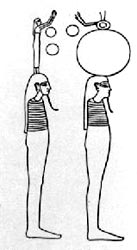
FIG. 20: ‘THE ONE BEING BORN’
The Tomb of Ramesses VI, Dynasty 20
There are other things touched on in Death of Gods besides discussions of precession and eclipses. There is speculation about the Sed Festivals and their timing, and there is speculation about ritual regicide in Egypt’s early history, much as I would have wished to avoid it. Certain signs had to be investigated and certain conclusions at least approached. But… it should be obvious that I feel on the firmest ground when I speak of eclipses of the sun. Eclipses are not at all hard for the reader to visualize, nor difficult to believe that such events were traumatic for an ancient civilization who made the sun one of its primary gods. Precession is another thing… although my researches led to my own conviction of its role in the creation of myths.
In closing, here are three illustrations, along with their original texts. I suggest that the Twentieth Dynasty had not brought certainty to the Egyptian interpretation of the mysterious eclipse, with its mysterious Diamond Ring Effects. At one time I believe that they had seen an eclipse as a great battle, with an eye and a testicle being torn out, but now the fear would appear to have been diffused. The eclipse drama is seen as a rebirth after death, with rebirth being the appearance of the Diamond Ring… or the egg, if you will, from which life is born.
‘I Was Conceived In The Abyss. I Was Born In The Abyss.’
The Inscription Above The First Mummy Reads: ‘This God Is Like This, He Supports The One Being Born.’ In Front Of The First Mummy Are The Words: ‘The One Of The Egg’
There is also the very interesting illustration titled, “The Great Secret’… but to see that, one must either visit Ramesses tomb, or look in my book.
Jane B. Sellers






